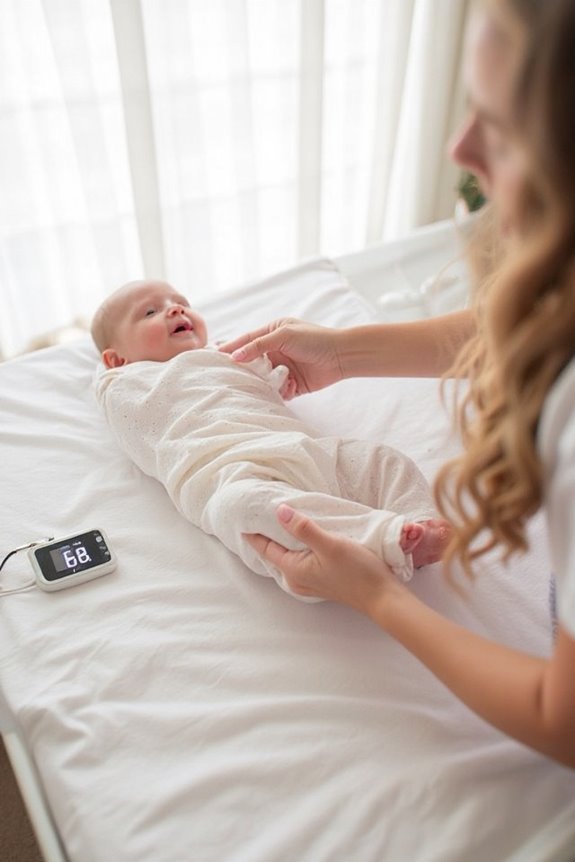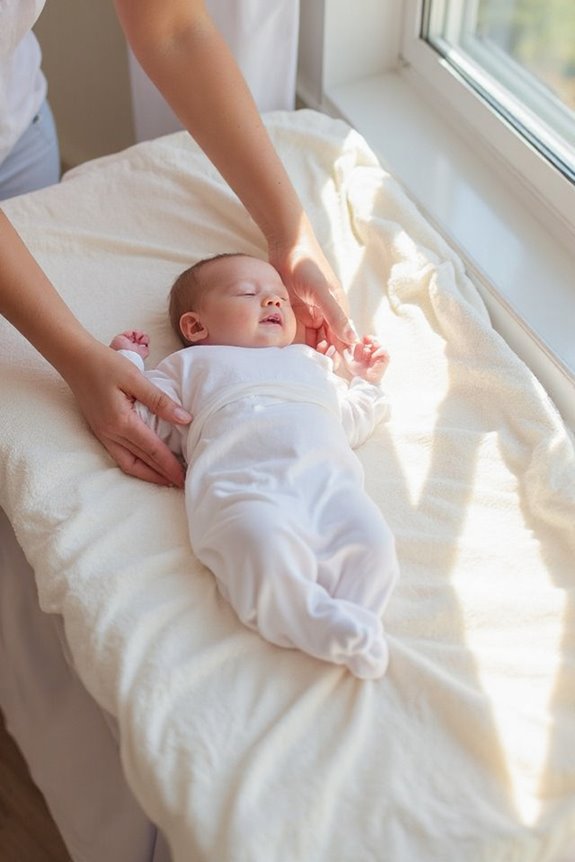To swaddle your baby safely, use a lightweight square blanket (40-48 inches) and place baby with neck above the top edge. Wrap one side across their right arm, tuck beneath them, then fold bottom up and wrap the other side across their left arm. Keep the wrap snug around the chest but loose around the hips and legs to allow natural “frog-like” positioning. Always place swaddled babies on their backs and stop swaddling once they can roll over. The following guide covers everything you’ll need for perfect swaddling technique.
Key Takeaways
- Always place swaddled babies on their backs to sleep, never on sides or stomach.
- Ensure hips can flex and move in a frog-like position to prevent hip dysplasia.
- Use breathable fabrics like cotton or muslin and watch for signs of overheating.
- Wrap snugly around the torso but leave room for leg movement and hip flexion.
- Stop swaddling once baby shows signs of rolling over, typically around 2-3 months.
The Importance of Safe Swaddling Practices
While swaddling has been practiced for centuries by parents worldwide, it’s crucial to understand proper techniques to guarantee your baby’s safety and development. When done correctly, swaddling benefits include improved sleep quality and effective soothing techniques for distressed infants.
Safe swaddling requires:
- Keeping the wrap snug but not tight
- Positioning hips in slight flexion for healthy development
- Always placing swaddled babies on their backs
- Stopping once your baby can roll over
I can’t emphasize enough how important it is to follow recommendations from organizations like the AAP and the International Hip Dysplasia Institute. Improper swaddling increases risks of hip dysplasia and, if combined with stomach sleeping, may elevate SIDS risk. Monitor your baby regularly to confirm the swaddle remains secure but comfortable.
Selecting the Perfect Swaddle for Your Baby
Now that you understand safe swaddling practices, let’s examine how to choose the right swaddle for your baby. When evaluating swaddle types, prioritize safety over trends.
Consider these key factors:
- Swaddle Types: Traditional cotton or muslin swaddles offer breathability, while velcro and zipper options provide easier securing. Avoid weighted swaddles, as they’re not recommended by the AAP.
- Fabric Choices: Muslin excels in breathability, while organic cotton offers chemical-free comfort. Bamboo provides excellent moisture-wicking properties.
Look for:
- Secure closures that won’t come undone
- Breathable materials to prevent overheating
- Adjustable designs that grow with your baby
- No loose fabric that could pose suffocation risks
Brands like Aden + Anais, SwaddleMe, and Love To Dream offer reliable options with various safety features.
Step-by-Step Swaddling Technique

Mastering the art of proper baby swaddling requires following a precise technique that guarantees both safety and comfort for your little one. I’ve found that successful swaddling delivers numerous swaddle benefits, including better sleep and reduced startle reflexes.
To begin:
- Place baby on a 47-inch square cotton blanket with neck above the fold
- Fold the top point down toward center
- Secure right arm against baby’s side, pull blanket across and tuck under left side
- Bring bottom point up, then secure left arm similarly
- Tuck final corner across body snugly
Among swaddle variations, velcro options offer easier application while maintaining safety. Always verify the swaddle isn’t too tight around legs but secure enough to prevent unraveling. Check that baby isn’t overheating and that no loose blankets remain in the sleeping area.
Proper Hip and Leg Positioning
Three essential aspects of safe baby swaddling involve proper hip and leg positioning to prevent developmental issues. When swaddling your baby:
- Always guarantee hip flexion, with legs bent upward and outward in a natural “frog-like” position
- Allow for leg abduction (keeping legs apart) rather than forcing them straight down and together
- Leave enough room in the lower portion of the swaddle for movement
This positioning is vital because restricting leg movement or forcing extended, straight legs can contribute to hip dysplasia. The International Hip Dysplasia Institute recommends the “jockey position” where knees are slightly higher than buttocks.
I recommend swaddling only the upper body tightly while keeping the lower wrap loose enough for natural leg movement. This balance provides comfort while protecting your baby’s developing hip joints.
Monitoring Temperature and Preventing Overheating

Maintaining your baby’s ideal body temperature during swaddling is essential to prevent the dangerous risk of overheating. Proper temperature regulation starts with your baby’s environment:
- Keep room temperature between 16°C to 20°C
- Position the swaddled baby away from heaters or radiators
- Use only breathable fabrics like cotton or muslin
- Dress your baby in light clothing under the swaddle
Regularly check for overheating signs by feeling the back of your baby’s neck or chest—these areas should feel warm but not hot or sweaty. If your baby appears flushed or is sweating, remove the swaddle immediately.
Never use hats, thick blankets, or synthetic materials when swaddling, as these greatly increase overheating risks. Adjust swaddling layers according to seasonal changes to maintain consistent comfort.
When to Stop Swaddling
While monitoring your baby’s temperature is important, knowing exactly when to stop swaddling is equally essential for your child’s safety. I recommend watching for these key swaddle signs:
- Rolling over attempts (usually between 2-6 months)
- Resisting the swaddle or breaking free
- Increased mobility during sleep
The change timing varies for each baby – some show rolling signs as early as 8 weeks, while others develop this skill later. Most babies change around 2-3 months old.
For safety reasons, you must stop swaddling before your baby rolls over completely. A swaddled baby who rolls onto their stomach faces serious suffocation risks. When you notice these developmental cues, begin a gradual change to arms-free sleep using sleep sacks or wearable blankets to maintain comfort while allowing safe movement.
Swaddle Alternatives for Growing Babies
When your baby begins showing signs of rolling over, it’s time to explore safer sleep options beyond traditional swaddling. I recommend considering these alternatives that balance security with necessary freedom of movement:
- Wearable blankets provide a cozy feeling while allowing arm mobility and proper hip development
- Sleep sacks offer security without restricting leg movement, ideal for active sleepers
- Zipadee-Zip designs work well for babies who can roll, giving star-shaped freedom
When selecting an alternative:
- Choose breathable fabrics to prevent overheating
- Confirm proper sizing for comfort and safety
- Consider ease of diaper changes with accessible zippers
The shift should be gradual. I suggest starting with one nap in the new sleep garment before moving to overnight use. Monitor your baby’s response and adjust as needed.
Nighttime Safety Tips for Swaddled Infants
Safe nighttime swaddling requires careful attention to both technique and environment. While swaddling benefits include improved sleep and reduced startle reflexes, safety must always come first.
Sleep Environment:
- Place swaddled babies only on their backs on a firm, flat mattress
- Keep the crib completely clear of toys, pillows, and loose blankets
- Never use weighted swaddles, as these pose serious risks
Monitoring Guidelines:
- Check that only the baby’s head and neck remain outside the swaddle
- Verify the swaddle is snug but allows for chest expansion (you should be able to fit one hand between the blanket and baby’s chest)
- Stop swaddling once your baby shows signs of rolling (typically around 2 months)
These precautions maximize baby comfort while minimizing suffocation and SIDS risks during nighttime sleep.
Common Swaddling Mistakes and How to Avoid Them
Despite your best intentions, several common swaddling mistakes can compromise your baby’s safety and comfort. I’ve identified the most vital errors to help you avoid them:
- Wrapping too tightly around the chest. Always verify two fingers fit between the swaddle fabric and your baby’s chest to allow proper breathing.
- Restricting hip movement. Legs should bend and flex naturally in a “frog” position to prevent hip dysplasia.
- Positioning the swaddle too high. Keep all swaddle fabric below the neck to prevent suffocation risks.
- Using inappropriate sizes. Select 40-48 inch square blankets or purpose-designed swaddles for newborns.
- Creating loose wraps. Master proper swaddling techniques that secure the midsection while allowing leg movement, as loose fabric can unravel and cover your baby’s face.
Frequently Asked Questions
Can I Swaddle My Baby for Daytime Naps?
I absolutely recommend daytime swaddling for naps! It offers the same benefits as nighttime—improved sleep quality and comfort. Just maintain swaddling sleep safety by monitoring your baby and stopping once they show signs of rolling over.
Is It Safe to Breastfeed While My Baby Is Swaddled?
70% of swaddled babies show fewer feeding cues. I’d recommend unwrapping your baby before breastfeeding since swaddling restricts arm movements needed for proper latching. Try various breastfeeding positions once your baby’s unswaddled for better feeding success.
Should I Swaddle My Baby During Medical Procedures?
I recommend swaddling during medical procedures for its calming benefits. Swaddling techniques can comfort your baby without medication, but guarantee medical staff monitor your little one closely and use proper swaddling techniques throughout the procedure.
Can Swaddling Affect My Baby’s Motor Skill Development?
I’ve found swaddling benefits my baby’s sleep without harming motor skills development. I make sure she gets plenty of unswaddled time daily for movement practice, balancing the comfort of swaddling with motor development needs.
How Should I Swaddle Twins or Multiples?
Like juggling precious gems, swaddling twins requires precision. I’d recommend using separate swaddles for each baby, keeping their hips loose, and placing them in separate sleep spaces. These twins swaddling techniques prioritize safety tips.
References:
https://safesleepacademy.org/swaddling-safe-sleep/
https://www.stlouischildrens.org/health-resources/pulse/right-way-wrap
https://www.healthychildren.org/English/ages-stages/baby/diapers-clothing/Pages/Swaddling-Is-it-Safe.aspx
https://hipdysplasia.org/infant-child/hip-healthy-swaddling/
https://takingcarababies.com/how-to-swaddle-a-baby
https://nichq.org/blog/health-professionals-need-talk-families-about-swaddling/
https://www.aap.org/en/patient-care/safe-sleep/healthy-children-safe-sleep-articles/
https://themamanotes.com/an-overview-of-the-most-popular-baby-swaddles/
https://www.nestedbean.com/blogs/zen-blog/types-of-swaddles
https://www.babygearlab.com/topics/activity-soothing/best-swaddle-and-sleep-sack





